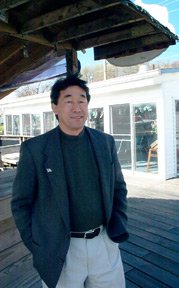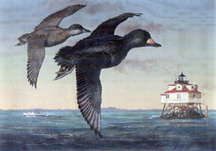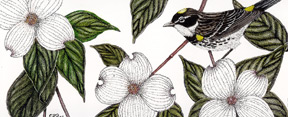|
|
 Llandmarks: Circling Back to the Old Lothian Post Office Llandmarks: Circling Back to the Old Lothian Post Office
First a traffic circle, now Ollie Miller’s Gallery of Fine Art.
If you’re new to the area, you might wonder what Lothian is coming to, what with so much modernity on Route 2 just above its intersection with Routes 408 and 422. But if your perspective is a little longer, you’ll know Ollie Miller’s circled back home.
At the small stand-alone building where Ollie Miller now raises her flag, her mother, Nettie M. Ford, long raised the flag as Lothian postmaster.
“When I put the flag up every morning, I think to myself, ‘I’m doing what my mother would do,’” says Miller. “Mother would be so pleased.”
Miller’s gallery — designed by her brother-in-law, architect Ben W. Carr — was built as a post office and dedicated to her mother in 1962. Before that, 42-year Lothian postmistress Nettie Ford had raised her flag in the general store owned and operated by her husband, James Alvin Ford.
The Fords’ daughter Ollie was born 64 years ago across the road from the post office-become-gallery, delivered by country doctor-become-local-legend Emily Wilson. That house first became the area’s health clinic; then, for the past 30 years, home to Miller’s interior design business.
From the windows of her gallery, Miller looks out on a world much changed since her youth. Yet beneath change, continuity runs deep.
 |
Once the Post Office where Ollie Miller’s mother worked as Postmaster, the building is now her own art gallery.
photos by M.L. Faunce
|
Looking across Route 2, Miller recalls that when she was growing up, “everyone began their morning right there. It was the hub,” she says of the politicians and local folks dropping in when her father, known as Buck, had the general store and service station. He also served in the Maryland General Assembly.
After her father’s death in 1948, her mother — “an amazing woman and a striking beauty,” Miller says — took over the service station. Still Amoco, it’s now owned by Miller’s brother Harry Ford on the site of the old general store. Her sister, Judy McHenry, lives across the road.
Their mother’s post office moved to Waysons Corner in the 1990s, and the old building eventually became Lothian Antiques. When that enterprise moved out last year, it hit Miller “like a bolt of lightning” that the family-owned building would lend itself to gallery space. The businesswoman was so enthusiastic that she didn’t survey the market before she opened her doors.
She counted instead on her knowledge of the area and of her clients’ tastes. For 17 years she ran the Chifforobe in equally rural Harwood, selling upscale women’s clothing.
Back at the old post office, the energetic Miller and her husband, James, worked as a team, transforming the interior into a bright, open studio “that’s more like a home” to show paintings in a setting clients can relate to.
With the walls hung with oils and watercolors of local artists trained in “the classical, technical way,” the doors opened in mid-February. Some 150 people revisited the old post office to see what the Ollie Miller Gallery was up to now.
As the gallery name suggests, Miller emphasizes the word “fine.” Prices listed next to works displayed in the gallery reflect, Miller says, a level of “high professionalism.” You’ll find no prints, but you may find copies of original artwork drawn from “old masters.”
The artists bear names as familiar in their own way as the family names of Chesapeake Country. Among them are Charlotte Berry, Ann Bradshaw, Henry Jaecks and Jean Brinton Jaecks, Dan Kuhne, Pat McHold, John Taylor and Jennifer Wharton.
In May, Chesapeake Country wildlife and landscape artist John Taylor [“Jug Bay’s Best Friend”: Vol. X, No. 12, March 21-27] will be Ollie Miller’s first featured artist. “I’m local, and he’s local,” says Miller.
It’s all art inside, but outside, Ollie Miller’s Gallery of Fine Art is true to its roots, flanked by a post office letter box and flagpole.
— M.L. Faunce
 |
| photo by Sonia Linebaugh |
Black Scoters at Thomas Point Light Take Prize
“You’d better go back and do your painting,” Kay Kinnett told her husband. “It’s God’s gift.”
So James Y. Kinnett picked up his brushes after a 20-year hiatus and, now, for the long months since his wife’s cancer death in January 2001, he has poured his attention into painting seven days a week.
Last year, as Kinnett made his way back to Maryland from his wife’s family home in Texas, he worked on a design of black scoters flying over the Bay with Thomas Point Lighthouse in the background. He finished the painting in a hotel in Tennessee in time to enter it in the fall Federal Duck Stamp competition. He didn’t win, but kept working to finish three more paintings in time for the Maryland Duck Stamp competition. Friends encouraged him to enter the black scoter painting as well. That proved to be Kinnett’s winner.
This marks the 28th year of the Maryland Migratory Waterfowl Stamp Design competition, as it is officially named, sponsored by Maryland Department of Natural Resources. Proceeds from the sale of Duck Stamps, at $6 each to waterfowl hunters and collectors, have brought the department $4 million since 1974 when Edgewater artist John Taylor took first prize. The stamps help pay for waterfowl research and habitat enhancement on Maryland’s public lands. Recent projects include control of the invasive wetland plant phragmities at Merkle wildlife management area on the Patuxent River.
 |
After a 20-year hiatus from painting, artist James Y. Kinnett, opposite, won the
Maryland Migratory Waterfowl Stamp Design competition with his black scoters flying over Thomas Point Lighthouse. |
Birds have always been winners for Kinnett. Born in Korea, he was adopted by an American service family, who brought him to Southern Maryland at age nine.
“I didn’t speak any English and I expected America to be like the pictures in catalogues,” Kinnett says of that time. “My memory is indistinct, but the transition was not so easy. I was in third grade and I found a baby robin. That’s what started my interest in birds. Every day before school, I went out and grubbed for worms to feed that baby,” he says.
Just as his unfolding interest helped Kinnett through the transition to a new land, it returned to help him recover after his wife’s death.
“I’ve always sketched and drawn, but after I got married I had to earn a living so I dropped art and got into marketing and sales,” he explained. “That’s not important any more. I’m lucky to have a second chance. God wants me to do something with this talent.”
Kinnett’s paintings are watercolors, with the colors applied with a dry brush on dry paper to create an opaque image.
“The hardest part is to get a perfect blend of tones in the sky or the background,” says Kinnett. “The birds are easy.”
He works from sketches and his own photographs, using elements from a combination of shots and his knowledge of birds to create a unique image. In this case, a taxidermist friend sent detail-photos of wings, head and tail from a black scoter pair he was planning to mount. Maryland friends contributed their photo of Thomas Point Lighthouse. Kinnett created the total design and the pose of the birds.
Kinnett was working in the garden when he heard about his win. The solicitation he expected when the phone rang turned out to be the news that he had taken first place in the Duck Stamp contest. There’s no monetary prize with the win, but the Duck Stamp award opens doors to book publishing and artist’s prints as well as adding to the reputation and price of an artist’s work.
So Kinnett doesn’t know quite what he’s won. “I don’t know what this is leading to,” he says. “I’d like to publish a book of Maryland birds.”
But he sure knows that he’s won. “The phone has been ringing off the hook for the last few days,” says he. “It’s wonderful. It’s a culmination of all my hard work. I feel very blessed.”
— Sonia Linebaugh
Opening Day, 1930 Census

Opening Day at Camden Yards had nothing on the start of a new season indoors at the National Archives in Washington and 13 other locations around the country. On the same day baseball fans headed to park to see the first ball thrown out, genealogists and amateur family historians stormed the doors of microfilm reading rooms for arcane bits of information in the newly released 1930 Census records.
Every 10 years, microfilmed records of personal data about every person counted in the decennial censuses are thrown open. It’s a regular field day for hunters anxiously waiting for the next booty of background on their ancestors. To these stalwart diggers of history, no wafting aroma of peanuts and popcorn could be quite as alluring as the dry-as-dust microfilmed records they reel through, wearing a look as intense as a starting pitcher’s.
The opening of the 15th Census of the United States, taken 72 years ago on April 1, 1930, was no different. For confidentiality and privacy, census records are closed by law for 72 years, once the expected average life span.
Each census taken has gathered slightly different data. The 1930 census offers a fairly broad snapshot of individuals and of family make-up. Personal descriptions include sex, race, age and marital status; level of education and literacy; occupation, work status and military history. At the family level, census-takers inquired into the relationship of those residing together; whether they owned or rented their home; if they lived on a farm; and whether they owned a radio.
More specifics rich for family historians were also asked in 1930: citizenship; the place of birth of parents; whether they were foreign born; and the language they spoke at home before coming to the United States.
There’s no umpire at the Microfilm Reading Room at the Archives in Washington, DC at Seventh Street and Pennsylvania Avenue, N.W., but staff and helpful volunteer docents will guide you through the maze.
Two days after opening day, Bay Weekly found microfilm readers freely available. At the next console, a pair of family historians reeled away, finding their parents and grandparents somewhere in Kansas. One read the data; the other wrote down the specifics — erasing once or twice after hearing “scratch that, I got on the wrong line.”
To get on the right line in the 1930 census, here’s what you might want to know: Soundex indexing — a system of coding surnames by the first letter and assigning numbers to the remaining letters — helps the researcher locate names. But the 1930 census is Soundexed for only 10 entire states plus counties of Kentucky and West Virginia. For the rest, including Maryland, you must search geographically, and to do that you need to know the street address of the person you seek.
Before you take your trip to the archives, get oriented with the excellent guide the National Archives and Records Administration has posted on its web site: http://1930census.archives.gov.
— M. L. Faunce
In Season: Yellow-Rumped Warbler
by Gary Pendleton

Large flocks of yellow-rumped warblers are passing through on their way to Canada and the Northeast. The birds over-wintered in the southern United States, with large concentrations in coastal areas where they fed on the waxy berries of the myrtle bush, a food that other birds cannot digest.
So attached are they to myrtle, the bird was officially named the myrtle warbler until a few years ago. The new name conferred by the American Ornithological Union refers to the yellow patch above the tail. Birders affectionately refer to these warblers as butter butts.
Their plumage suddenly changed about the time the dogwood blossoms fully opened. The male birds have bright yellow and deep black patches that were dull just weeks before.
Along with them, everything outside seems to be waking up. For weeks now, frogs have been calling in the wetlands and the petals of the spring beauties have been open. In addition to the yellow-rumped warblers, the parula, the yellow-throated warblers and the blue-gray gnatcatcher are making noise.
The yellow-rumped warbler is the only member of the family parulidae (wood warblers) that passes the winter in large numbers in North America. By the end of the first week of May, a great diversity of songbirds will have arrived from the tropics, but the yellow-rumped birds will be well on their way northward.
Spring officially began in March. If you judge by the thermometer and not the calendar, the first day may have been back in February. By my way of reckoning, the passing of the flocks of yellow-rumped warblers means that spring is well under way.
Way Downstream …
In College Park, a new study predicts that Chesapeake Bay wetlands may be submerged by century’s end if global warming continues to raise sea levels. The study, based on satellite photos, found that over two-thirds of our wildlife-rich Bay-filtering marshes already have suffered damage from rising waters …
In Italy, the Milan Design Fair featured some new creations by pet-lovers. You probably can’t wait to purchase the iguana sofa or the goldfish bowl with separate rooms so that your little fellow no longer has to spend his life swimming in circles …
Our Creature Feature comes from Australia where, as the saying goes, they can pull a hat out of a rabbit. Call them Akubra, those famous droopy, weathered hats that make you think Aussie when you see one.
But there’s a new problem: It takes 14 rabbit pelts to make just one hat at the Akubra factory in the town of Kempsey, north of Sydney. And a disease that was intentionally introduced to cull the country’s voracious rabbit population has worked: Up to 90 percent have died in some areas. As a result, some of the famous Australian hats now are being made from imported rabbit pelts, Reuters reports.
Copyright 2002
Bay Weekly
|